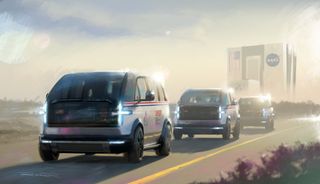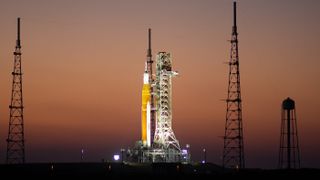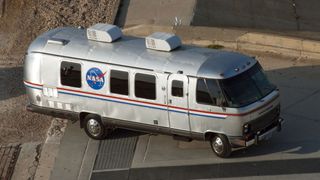NASA's Artemis astronauts will ride to launchpad in sleek new electric vans
Future NASA moon crews will have an electric ride to the launchpad.

Future moon crews will have an electric ride to the launchpad.
Starting with Artemis 2, the mission NASA hopes to send around the moon in 2024, crews will take their last ride on Earth before launch using electric crew transportation vehicles provided by Canoo Technologies Inc.
Canoo will supply a fleet of three to ferry the spacesuited astronauts, their support team and any needed equipment 9 miles (14.5 kilometers) from the Neil Armstrong Operations and Checkout Building to Launch Pad 39B at NASA's Kennedy Space Center (KSC) in Florida.
"The new transports will be based on the company's all-electric LV [launch vehicle] models, customized for NASA's unique needs," the agency stated on April 13.
"For example, the vehicles are required to seat eight, including four fully suited crew members," the agency continued. "The futuristic transports with pod-shaped exteriors will be an environmentally friendly solution, using zero-emissions technology for the next generation of explorers."
Related: NASA's Artemis 1 moon mission explained in photos

Similarly to the space shuttle era, NASA plans to use the new vehicles to carry the crews to the launchpad, but the fleet will also support prelaunch operations, training and launch countdown rehearsal tests, the agency said. The vehicles should be delivered no later than June 2023, NASA added.
Get the Space.com Newsletter
Breaking space news, the latest updates on rocket launches, skywatching events and more!
The agency released the news the same week it was attempting to complete a crucial "wet dress rehearsal" for Artemis 1, an uncrewed predecessor to demonstrate an orbital mission around the moon. The rehearsal was halted Thursday (April 14) after a series of glitches, and NASA later decided to roll the Artemis 1 stack off the pad to address the issues. It's unclear when the wet dress will resume.

The new electric vehicle will replace the shuttle-era "Astrovan" that transported NASA crews to the launchpad for launch dress rehearsal, on launch day and after landing. The modified Airstream transport van was used from shuttle missions STS-9 through STS-135, between November 1983 and July 2011. The van is now on display at the KSC visitor center.
But the new electric vehicles are not the only way NASA astronauts can get to the launchpad these days. SpaceX uses a Tesla Model X to get crews to KSC's Launch Pad 39A for Crew Dragon missions, and Boeing plans to use a customized Airstream Atlas Touring Coach, dubbed Astrovan II, when it starts crewed missions using its Starliner capsule.
Other vehicles were used for early space missions. The Mercury 7 astronauts traveled in a modified trailer pulled by a REO Motor Co. tractor, Gemini astronauts used a different transfer van, and Apollo, Apollo-Soyuz and early shuttle crews had their own "Astrovan," a converted Clark Cortez motor home.
Follow Elizabeth Howell on Twitter @howellspace. Follow us on Twitter @Spacedotcom and on Facebook.
Join our Space Forums to keep talking space on the latest missions, night sky and more! And if you have a news tip, correction or comment, let us know at: community@space.com.

Elizabeth Howell (she/her), Ph.D., is a staff writer in the spaceflight channel since 2022 covering diversity, education and gaming as well. She was contributing writer for Space.com for 10 years before joining full-time. Elizabeth's reporting includes multiple exclusives with the White House and Office of the Vice-President of the United States, an exclusive conversation with aspiring space tourist (and NSYNC bassist) Lance Bass, speaking several times with the International Space Station, witnessing five human spaceflight launches on two continents, flying parabolic, working inside a spacesuit, and participating in a simulated Mars mission. Her latest book, "Why Am I Taller?", is co-written with astronaut Dave Williams. Elizabeth holds a Ph.D. and M.Sc. in Space Studies from the University of North Dakota, a Bachelor of Journalism from Canada's Carleton University and a Bachelor of History from Canada's Athabasca University. Elizabeth is also a post-secondary instructor in communications and science at several institutions since 2015; her experience includes developing and teaching an astronomy course at Canada's Algonquin College (with Indigenous content as well) to more than 1,000 students since 2020. Elizabeth first got interested in space after watching the movie Apollo 13 in 1996, and still wants to be an astronaut someday. Mastodon: https://qoto.org/@howellspace
